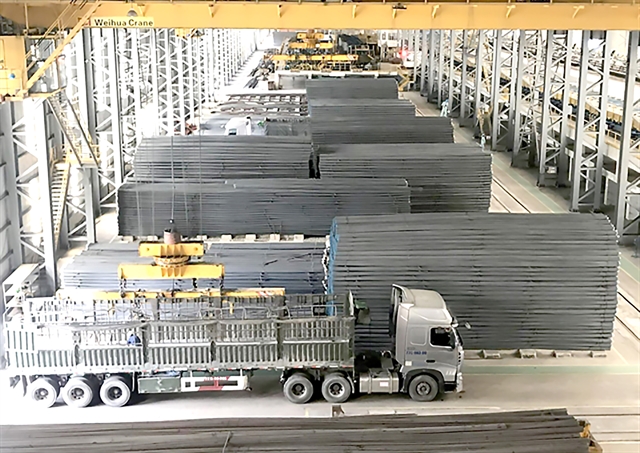 Economy
Economy

 |
| Products loaded on a truck at a warehouse of Hoà Phát Group. The group recorded a net loss of more than VNĐ2 trillion (US$85.3 million) in the fourth quarter of 2022. Photo hoaphat.com.vn |
HÀ NỘI Steel companies witnessed hardships in the fourth quarter of 2022 with many big players suffering losses.
Giant steel maker Hoà Phát Group (HPG) recorded a net loss of more than VNĐ2 trillion (US$85.3 million) in the fourth quarter, a new bottom after the third quarter where it recorded a loss of nearly VNĐ1.8 trillion.
In the last quarter of last year, the group's revenue also decreased by 42 per cent over the same period of the previous year, to VNĐ26 trillion. In the whole of 2022, Hoà Phát Group recorded revenue of VNĐ142 trillion, down 5 per cent year-on-year. Profit after tax for the whole year reached more than VNĐ8.4 trillion, only one-fourth of that in 2021.
In the fourth quarter of 2022, Hoa Sen Group (HSG) suffered a loss of VNĐ680 billion, down from VNĐ887 billion in the third quarter of 2022. Việt Nam Steel Corporation (TVN) reduced its loss from VNĐ567 billion in Q3 to VNĐ410 billion in Q4. Nam Kim Group (NKG) and Tisco (TIS) also reduced their losses compared to the previous quarter, reaching VNĐ356 billion and VNĐ17 billion, respectively.
The decrease in consumption volume combined with the continuous decline in prices significantly affected the revenue of steel enterprises. According to data from the Việt Nam Steel Association (VSA), total steel product consumption in 2022 reached 27.3 million tonnes, down 7.2 per cent compared to 2021. Total exports were 6.28 million tonnes, down nearly 20 per cent.
Construction steel was the only item that recorded a slight increase in output by 3 per cent over the same period of the previous year. Meanwhile, consumption of galvanised steel decreased by 22 per cent mainly due to the weakening of the export market, down by 38 per cent. Sales of products of galvanised steel and steel pipes declined, causing the output of hot rolled coil (HRC) to decrease by more than 13 per cent.
Is the most difficult period over?
Although continuing to report losses, Hoà Phát is quite optimistic about the situation of the steel industry this year. The Group said that "the steel industry has gone through the most difficult period and is on the way to recover" and is closely monitoring market developments to adjust production and business activities flexibly. Hoà Phát's steel sales volume increased again in the last month of 2022 after many previous decreases.
According to Kallanish, Hoà Phát has restarted a blast furnace in Hải Dương and increased its bar steel capacity by 700,000 tonnes per year. This is also a signal that the situation of the construction steel market has improved. Previously, Hoà Phát closed three blast furnaces in the last two months of 2022. The company also continues to invest in Hoà Phát Dung Quât 2 Iron and Steel Production Complex.
According to the forecast of the World Steel Association (Worldsteel), global steel demand is estimated to decrease by 2.3 per cent in 2022 but will increase by 1 per cent in 2023 and reach 1,815 million tonnes. The reopening of China will help the resumption of construction activities and boost infrastructure investment, thereby helping construction steel demand recover. Increased industrial demand in the country will also help restore global supply chains. Steel selling price is also expected to increase again.
Rebar prices in China have recovered 19 per cent and are trading at their highest levels since mid-August last year. Meanwhile, the prices of coal - the most important material in steelmaking, have leveled off and shown signs of falling. This will probably support the profit margin of the steel industry in the future.
In addition, the Government stepping up investment in infrastructure projects with the goal of ensuring economic growth in 2023 may support domestic steel demand, especially construction steel. However, the real estate industry, after a quiet year in 2022, is not expected to recover in 2023, which will partly affect the recovery of domestic steel demand. VNS




